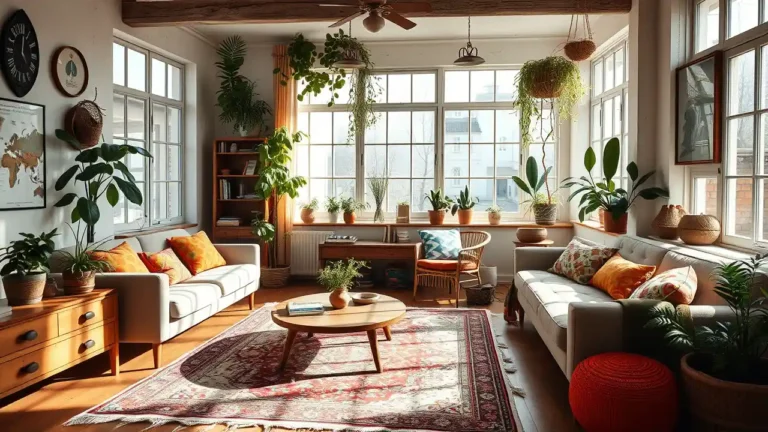Introduction
In a world where personalization and authenticity matter more than ever, boho interior design has emerged as a favorite among homeowners and interior design enthusiasts alike. Often shortened to “boho,” this decorating style is celebrated for its eclectic blend of vintage charm, global influences, and artistic expression. More than a passing trend, boho design embraces the beauty of imperfection and individuality, making every space uniquely expressive. In this article, we will delve into the origins, essential elements, and practical tips for incorporating bohemian style into your home. Whether you’re looking to revamp your living room, create a cozy bedroom, or even design a functional home office, this guide will provide you with the inspiration and actionable insights necessary to bring the boho spirit to life.
Table of Contents
What Is Boho Interior Design?
Defining Boho Style
At its core, boho interior design is all about celebrating artistic freedom and unconventional styles. The term “boho” derives from “bohemian,” a word historically associated with the free-spirited artists, writers, and travelers who rejected societal norms in favor of creative exploration. In terms of interior design, boho is characterized by a rich mix of colors, patterns, and textures that defy strict rules and celebrate diversity in aesthetics.
Unlike minimalist trends that emphasize clean lines and a limited color palette, boho design welcomes a seemingly chaotic mix of elements that, when blended harmoniously, create spaces full of warmth and personality. This style also encourages the incorporation of eclectic pieces collected over time—think vintage furniture, handcrafted ornaments, and international textiles.
Origins and Influences
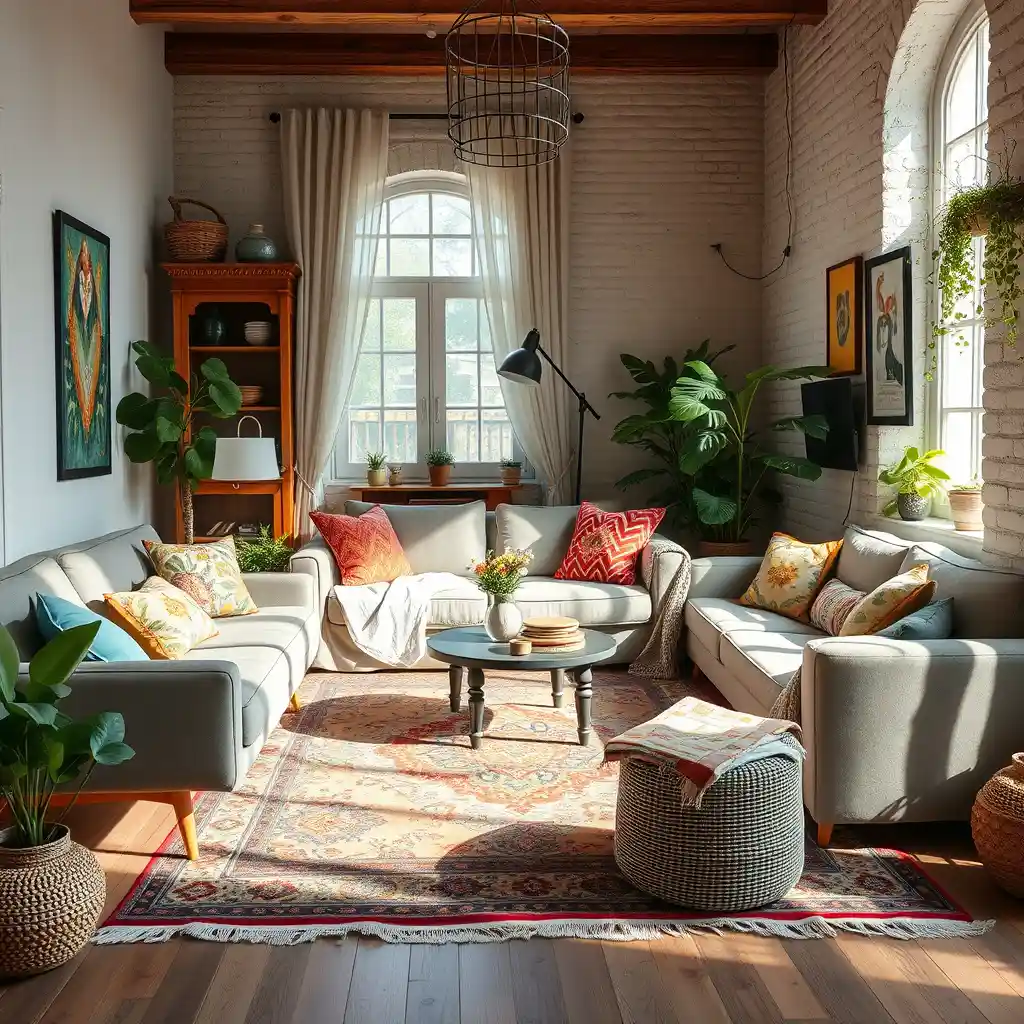
Boho interior design has deep cultural and historical roots. Its evolution can be seen through various movements and global influences:
- Historical Roots:
The bohemian lifestyle originated in the 19th century with European artists and writers who lived unconventional lives outside the bounds of traditional society. This spirit of rebellion and free-thinking continued into the 1960s and 1970s with the counterculture movements, which placed an emphasis on creativity over conformity. Today, this legacy is reflected in boho interiors that exude a sense of relaxed nonconformity. - Cultural Influences:
Bohemian design draws inspiration from a variety of cultures—particularly those from India, Morocco, and the Mediterranean region. For example, you might find rich, embroidered fabrics, vibrant tapestries, and intricate patterns reminiscent of traditional Indian textiles. Moroccan poufs, Persian rugs, and Mediterranean ceramics are also common elements that contribute to the boho vibe. - Modern Twists:
Modern boho design has evolved to integrate contemporary elements such as sleek, modern furniture juxtaposed with antique or artisanal pieces. Merging classic elements with modern design produces vibrant spaces that exude both timeless charm and contemporary appeal. While maintaining its free-spirited roots, modern boho accommodates the need for functionality and clean lines without sacrificing its eclectic nature.
Key Characteristics of Boho Interior Design
Understanding the defining features of boho interior design is essential for anyone looking to master the style. Here are some of the key characteristics:
- Vibrant and Earthy Color Palettes:
Boho design often features a mix of rich earth tones—such as terracotta, mustard, and olive green—with vibrant pops of color like deep blue, fuchsia, or sunset orange. This fusion creates a warm and inviting atmosphere that feels both grounded and lively. - Layered Textures and Patterns:
One of boho’s most distinctive elements is the use of multiple textures. From lush, patterned rugs and throw pillows to velvet sofas and distressed wooden tables, layering textures is the key to achieving depth in a boho space. The juxtaposition of smooth fabrics with rough, natural materials adds a tactile richness that engages all the senses. - Eclectic Furnishings:
Boho interiors often incorporate a mix of vintage finds and modern pieces. Expect to see mismatched furniture, global-inspired accessories, and personal mementos that together tell a unique story. Each piece, whether a hand-painted ceramic vase or a timeworn leather armchair, adds its own character to the overall design. - Natural Elements and Handmade Accessories:
Incorporation of natural materials such as wood, bamboo, and rattan is a hallmark of boho design. Additionally, handmade items such as macramé wall hangings, handwoven textiles, and artisanal décor elements are frequently used to add an authentic, personal touch.
Why Embrace Boho Interior Design?
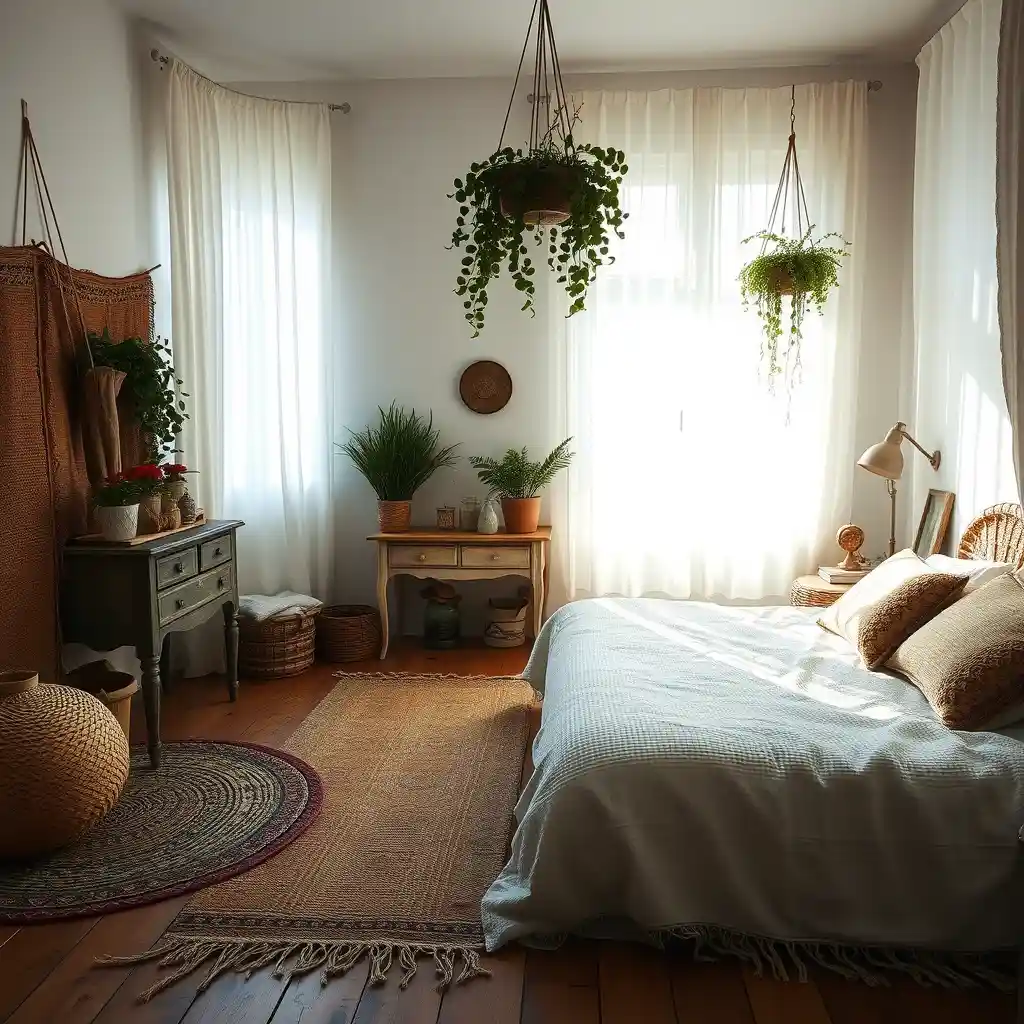
Creating a Personalized Space
One of the greatest appeals of boho interior design is its emphasis on personalization. Unlike more rigid design philosophies, boho thrives on the idea that every object and accessory should reflect the owner’s taste and experiences. This approach allows homeowners to curate a space that feels inherently personal and lived-in.
Imagine walking into a room where every piece of furniture has a story—perhaps a vintage sofa that belonged to a grandparent or an intricately woven wall hanging purchased during travels. This narrative quality not only makes the space unique but also creates an environment that exudes warmth and authenticity. Whether it’s your living room, bedroom, or even your kitchen, a boho-inspired space invites you to showcase your individuality and embrace the beauty of imperfection.
Warmth, Comfort, and Versatility
Boho interiors are renowned for their welcoming ambiance. The combination of layered textiles, natural materials, and vibrant colors creates a cozy and inviting atmosphere. This warmth and comfort are further enhanced by the casual, lived-in quality that boho decor encourages. Unlike sleek, sterile modern interiors, boho spaces invite you to relax, sink into plush furnishings, and linger in an environment that feels like a retreat.
Furthermore, boho design is incredibly versatile. Its inherent flexibility means that it can be adapted to suit various spaces and lifestyles. Whether you reside in a sprawling countryside home or a compact city apartment, boho design principles can be scaled up or down to suit your needs. The style’s adaptability makes it an ideal choice for those who enjoy mixing aesthetics and experimenting with new ideas.
Current Trends Shaping Boho Design
As with any design trend, boho interior design continues to evolve. Here are some contemporary trends influencing boho spaces today:
- DIY and Upcycling:
A growing number of boho enthusiasts are turning to DIY projects to create one-of-a-kind pieces. From refurbishing old furniture to crafting handmade wall art, DIY projects not only add personal touches but also promote sustainability through upcycling. - Sustainable Living:
With an increased focus on eco-conscious living, many are combining boho aesthetics with sustainable practices. Opting for reclaimed wood, organic fabrics, and locally sourced materials ensures that your design is as environmentally friendly as it is beautiful. - Digital Inspiration:
Social media platforms like Pinterest and Instagram have fueled the popularity of boho decor by offering endless inspiration. Interior design influencers and bloggers share mood boards, tutorials, and before-and-after transformations that help others envision the possibilities of boho style.
How to Create a Boho Chic Space
Transforming your home into a bohemian haven is an exciting process that involves creativity, planning, and experimentation. The following step-by-step guide provides a roadmap for achieving a successful boho-inspired space.
1. Planning and Gathering Inspiration
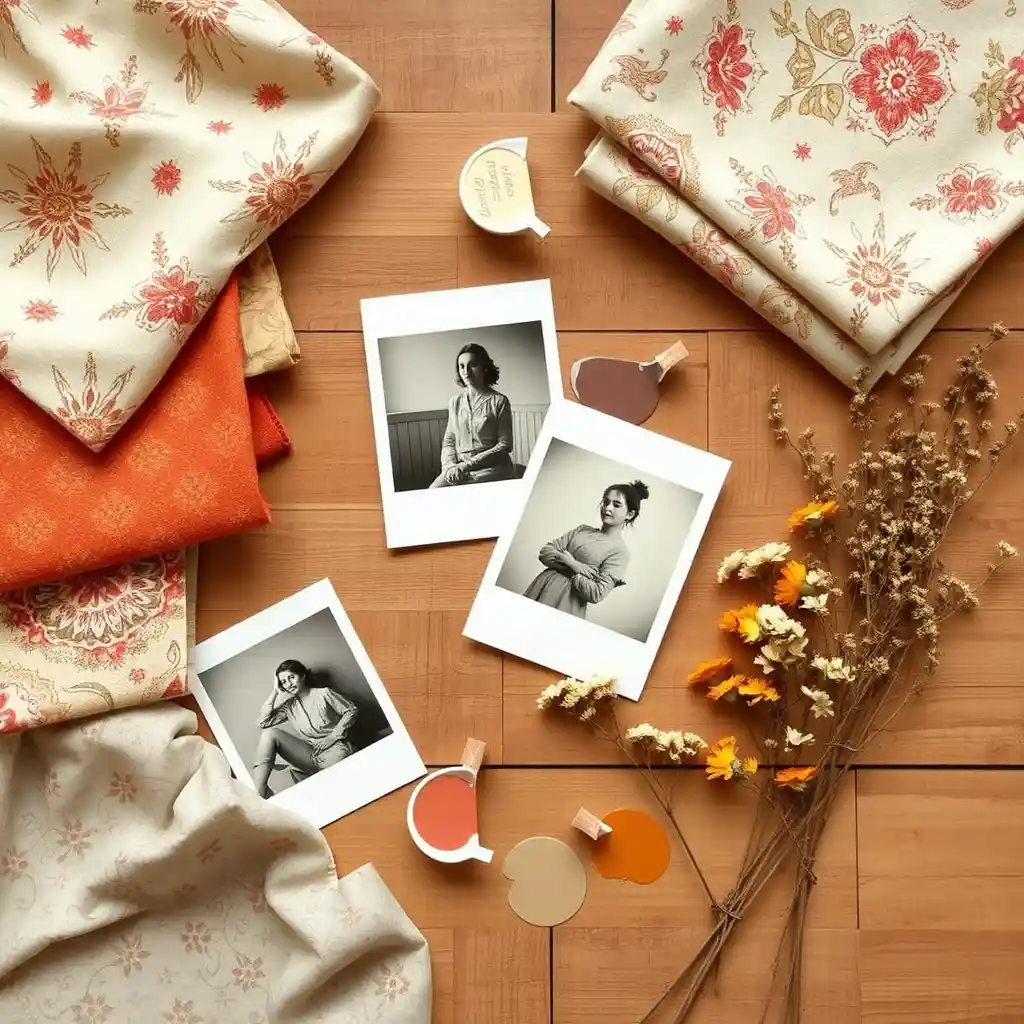
Create a Mood Board
Begin by gathering inspiration from various sources. Create a mood board—using physical cut-outs or digital tools such as Pinterest or Canva—that compiles images, textures, colors, and design elements that resonate with the boho aesthetic. Consider including elements like vintage furniture, patterned textiles, exotic souvenirs, and natural landscapes. This board will serve as your reference point throughout the design process.
Select Your Color Palette
The strategic use of color stands as one of the most essential elements in boho design. Typically, boho interiors blend warm earth tones with vibrant accent colors. For example, you might choose a base of soft beige or cream and then incorporate splashes of turquoise, deep red, or sunny yellow. Experiment with different combinations until you find a palette that creates harmony while still evoking the spirit of adventure and creativity.
Define Your Focal Points
Identify key areas or features in your space that you want to highlight. Whether it’s a statement wall, a vintage sofa, or an eye-catching piece of art, focal points help anchor the room and guide the overall design flow. Consider how each focal point will interact with the rest of your decor and plan your furnishings accordingly.
2. Furniture and Decor Selection
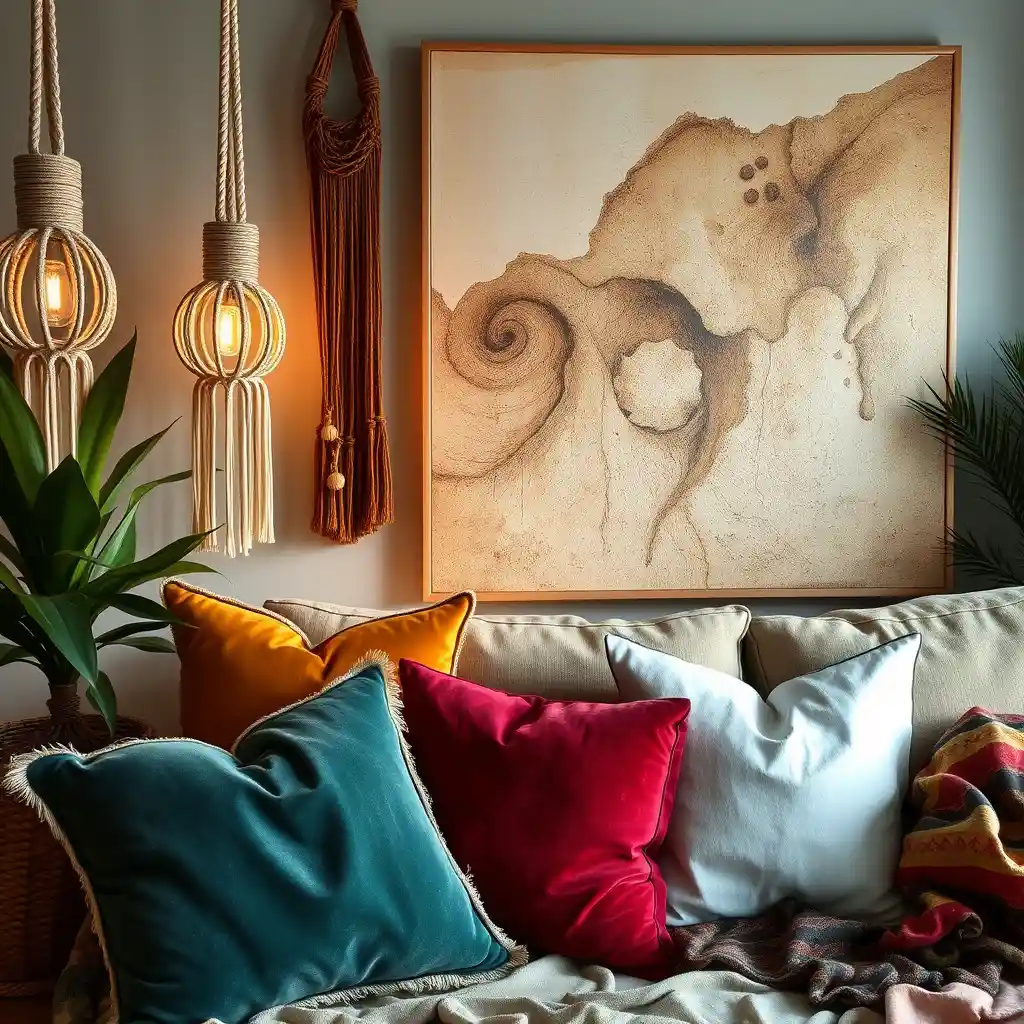
Combining Modern and Vintage Pieces
One of boho design’s signature techniques is the artful mix of modern and vintage elements. Start with a foundation of essential modern furniture pieces—such as a comfortable sofa or a streamlined dining table—that provide functionality. Then, layer in vintage accents like an ornate mirror, distressed coffee tables, or unique antiques that introduce history and character into the space.
For instance, in a boho living room, combine a streamlined, modern sectional with a hand-carved vintage coffee table and a striking Persian rug. This results in a space that is both modern in its functionality and richly imbued with nostalgic charm.
Emphasize Handcrafted Details
Handmade accessories add immeasurable value to boho interiors. Seek out artisanal pieces such as macramé wall hangings, handcrafted pottery, or handwoven baskets. Each item contributes a human touch that mass-produced products often lack. These details not only serve as decorative accents but also act as conversation starters that infuse your space with personality.
Incorporate Global Influences
Boho design is inherently global in scope. Integrate decorative items and patterns inspired by different cultures to create a diverse and vibrant look. Examples include:
- Moroccan poufs and lanterns for a touch of North African elegance.
- Indian block-printed textiles for rich, intricate patterns.
- Scandinavian minimalist furniture that offers contrast and balance. This blend of global influences ensures that your space feels worldly and open, echoing the bohemian love for travel and cultural exchange.
3. Working with Textures and Colors

Layering Textiles
A critical step in achieving the boho look is layering different textiles throughout the space. Think beyond standard curtains and pillows—experiment with a variety of fabrics such as woven throws, kilim rugs, embroidered cushions, and even a mix of area rugs with varying patterns and textures. The goal is to create visual and tactile depth that invites you to explore the space with your senses.
Concrete Example: In a bohemian bedroom, layer a soft, neutral duvet with patterned throw blankets and multiple decorative pillows in contrasting colors. A textured area rug underneath a low-profile bed can complete the look, ensuring that every element contributes to the overall warmth of the room.
Harmonizing Color
While boho design is known for its bold color choices, balance is key. Too many conflicting colors can overwhelm the space, so it’s important to define a cohesive color scheme. Use a primary palette of earthy tones as your base and then accentuate with brighter colors through artwork, throw pillows, or decorative accessories. This approach maintains energy while ensuring the room feels intentional and refined.
Embracing Nature
Natural elements are a cornerstone of boho interior design. Introduce plenty of indoor plants not only for their aesthetic appeal but also for their health benefits. Planters made from reclaimed materials or handmade ceramic pots further enhance the bohemian vibe. Consider low-maintenance succulents, ferns, or even larger statement plants like fiddle leaf figs to add both greenery and a touch of organic structure to your space.
4. Lighting and Creating Ambiance
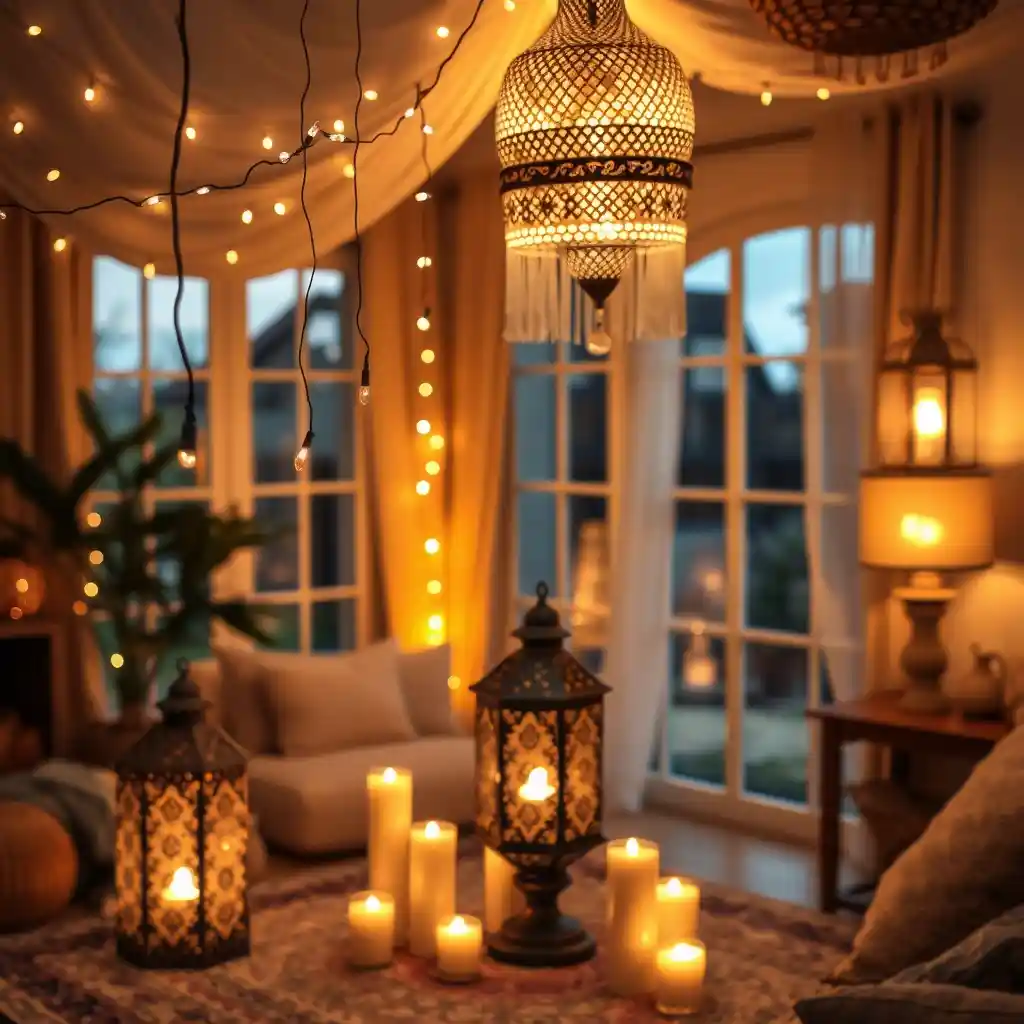
Ambient Lighting Techniques
Lighting plays a pivotal role in setting the mood of a boho space. Aim for a warm, inviting glow that enhances the layered textures and vibrant colors. Consider these ambient lighting solutions:
- String Lights: Drape fairy lights or Edison bulbs around windows, shelves, or headboards for a soft, enchanting effect.
- Candles and Lanterns: Place candles in decorative lanterns or holders to create pockets of warm light. Consider using flameless LED candles for safety without sacrificing style.
- Dimmer Switches: Installing dimmers allows you to adjust the light intensity according to the time of day or desired mood, making your space more versatile and welcoming.
Statement Lighting Fixtures
Don’t shy away from using lighting as a statement piece. Vintage chandeliers, handcrafted pendant lights, or even eclectic floor lamps can serve as focal points while providing practical illumination. For instance, a Moroccan lantern with intricate metalwork can become the centerpiece of a dining area, reflecting light in mesmerizing patterns on the walls and ceiling.
Real-Life Examples and Case Studies
To truly understand how boho interior design works in practice, it helps to look at concrete examples. The following case studies illustrate different ways to incorporate boho elements into various spaces.
Example 1: A Boho Living Room
Imagine a living room that effortlessly marries vintage charm with modern comfort. In this space, a plush sectional sofa serves as the centerpiece. The sofa is upholstered in neutral fabric, allowing layered throw pillows in deep blues, oranges, and patterned fabrics to stand out. A handwoven Persian rug with intricate designs anchors the seating area, while an assortment of ethnic artifacts and art pieces decorate the walls.
Additional touches might include:
- Vintage Coffee Table: A reclaimed wood table with a distressed finish provides both function and character.
- Global Accessories: A set of colorful Moroccan poufs offers additional seating and doubles as decorative accents.
- Natural Elements: Strategically placed indoor plants not only bring in nature but also soften the overall look.
Example 2: A Boho Bedroom Haven
A bohemian-inspired bedroom is all about creating an oasis of relaxation and creativity. Consider a spacious room with a large, inviting bed dressed in soft linens and an abundance of throw pillows. A vintage dresser—possibly discovered at a flea market—displays an eclectic mix of artisanal treasures and cherished personal photographs.
Additional details include:
- Textile Overload: Layering different bedding textures—such as a chunky knit throw over crisp cotton sheets—adds warmth and depth.
- Eclectic Artwork: A gallery wall featuring a mix of framed prints, tapestries, and handwritten notes can evoke personal history and travel experiences.
- Lighting: String lights and a few strategically placed table lamps with soft, warm bulbs contribute to a tranquil ambiance perfect for unwinding.
Example 3: A Boho-Style Home Office
Even your workspace can embrace the relaxed, creative spirit of boho design. In this scenario, a home office might feature a contemporary desk paired with a vintage accent chair. The room could incorporate a few thoughtfully arranged decorative items—such as a handwoven rug beneath the desk, a small collection of potted plants, and inspirational artwork on the walls—that combine to create an environment conducive to creative thinking and productivity.
Further enhancements could include:
- Personal Touches: A cork board or pinboard filled with inspirational quotes, photos, and travel souvenirs personalizes the space.
- Multifunctional Furniture: Using a storage bench or an ottoman with hidden storage keeps clutter at bay while maintaining the room’s boho chic vibe.
Tips and Tricks for Successful Boho Decorating
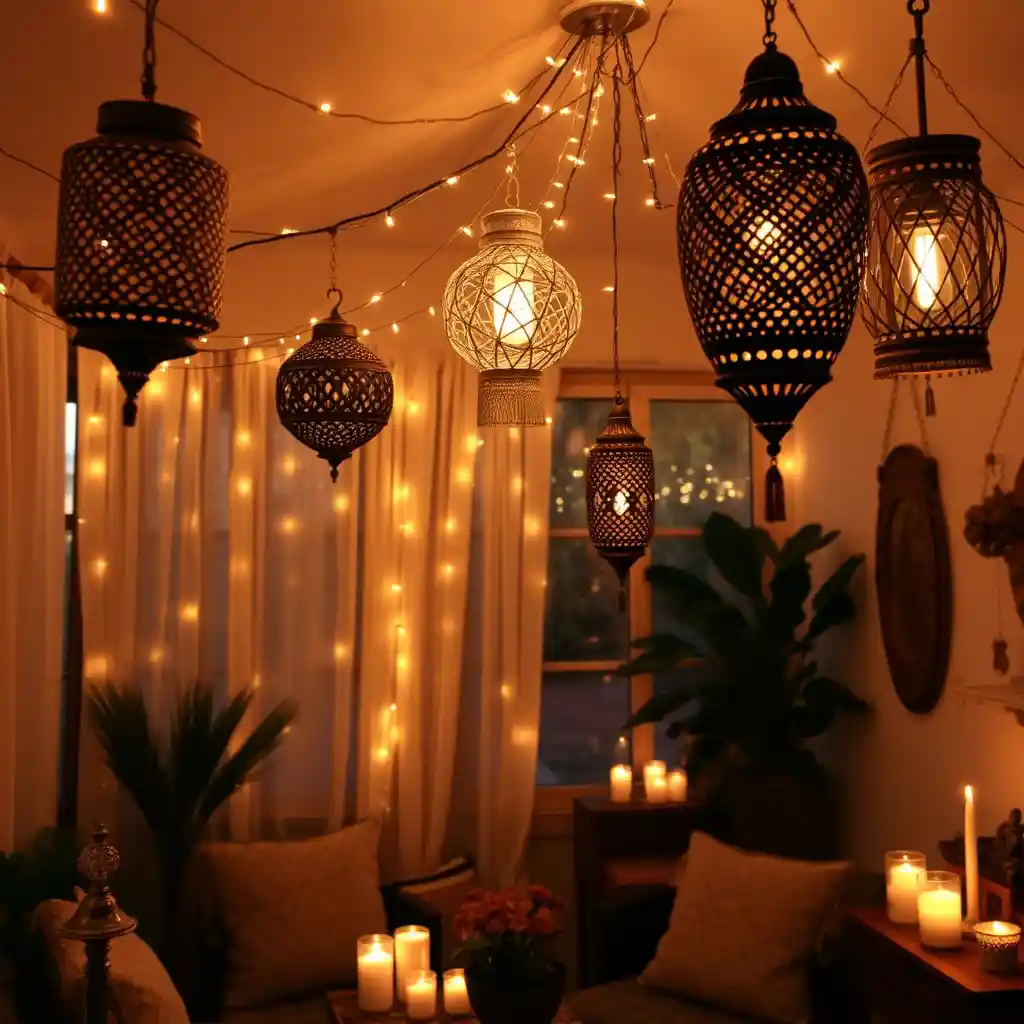
Whether you’re new to the boho style or a seasoned enthusiast, the following tips can help you perfect your bohemian decor while avoiding common pitfalls.
Budget-Friendly Ideas
Creating a boho interior doesn’t require a massive budget. Here are a few cost-effective strategies:
- DIY Projects: Engage in creative do-it-yourself projects. For example, create your own macramé wall hanging or refinish an old piece of furniture with a new coat of eco-friendly paint.
- Thrifting and Upcycling: Explore local thrift stores and flea markets to uncover hidden treasures that add a unique, vintage charm to your space.
- Affordable Accessories: Small items like decorative throw pillows, inexpensive wall art, or hand-painted ceramics can dramatically transform a room without breaking the bank.
Avoiding Common Mistakes
While boho design is wonderfully forgiving, there are some common missteps to watch out for:
- Overcrowding: Because boho style is all about layering, there’s a risk of creating a cluttered, overwhelming space. Be mindful of each area’s negative space—sometimes less is more when it comes to maintaining a balanced look.
- Lack of Cohesion: With so many elements at play, it’s crucial to maintain a unifying theme or color scheme. Overly disparate elements can lead to visual dissonance. Aim for a harmonious blend by anchoring your space with a consistent palette and similar materials.
Professional Insights and Advanced Techniques
For those looking to take their boho interior design to the next level, consider these advanced approaches:
- Design Planning Tools: Use digital tools like SketchUp or room-planning apps to visualize how different elements will fit together. Creating a 3D model can help you experiment with color, texture, and layout before making substantial changes.
- Consultation: Sometimes, hiring an interior designer who specializes in eclectic or bohemian styles can save you time and elevate your design. They offer expertise in sourcing unique pieces and ensuring a cohesive aesthetic.
- Seasonal Updates: Boho decor is dynamic—consider updating your accessories seasonally. Swap out textiles, add new plants, or change artwork to keep the space feeling fresh and reflective of your evolving tastes.
FAQs About Boho Interior Design
To further clarify common questions and provide additional insight, here are some frequently asked questions about boho interior design:
Q1: What exactly is boho interior design?
A1: Boho interior design is a style that celebrates artistic expression, individuality, and the eclectic mix of global influences. It combines vintage elements, diverse cultural patterns, and layered textures to create warm, personalized spaces.
Q2: What are the key elements required to achieve a boho look?
A2: Essential elements include layered textiles, a mix of vintage and modern furnishings, a rich and vibrant color palette, natural materials (like wood, rattan, and bamboo), handmade décor such as macramé and woven baskets, and plenty of indoor plants.
Q3: How can I incorporate boho decor into a small apartment?
A3: In smaller spaces, focus on quality over quantity. Choose a few statement pieces, use multi-functional furniture, and employ clever storage solutions. Opt for lighter colors and mirrors to create the illusion of space while layering smaller accessories that add character without overwhelming the room.
Q4: Is it possible to mix boho with other interior design styles?
A4: Absolutely! Boho’s versatility makes it an ideal partner for other styles such as modern minimalism or industrial chic. The key is to maintain a visual balance and cohesive color scheme so that the various elements complement rather than conflict with one another.
Q5: What are some budget-friendly tips for creating a boho interior?
A5: Embrace DIY projects, hunt for vintage finds in thrift stores, and make use of affordable accessories available online. Upcycling old furniture and leveraging handmade or repurposed décor can create an authentic boho feel without requiring a large budget.
Conclusion
Boho interior design is much more than an aesthetic—it’s a lifestyle. It embodies the freedom to express individuality, the passion for cultural diversity, and the joy of embracing imperfection. Whether you’re drawn to the warm, layered textiles, the vibrant color schemes, or the mix of vintage and modern elements, adopting the boho style means creating a space that tells your unique story.
In this article, we’ve explored everything from the origins of boho decor to actionable tips on how to plan, select, and layer elements to achieve the perfect bohemian look. We’ve also shared real-life case studies that serve as concrete examples of how boho style can transform living rooms, bedrooms, and even home offices into personalized havens. With thoughtful planning, careful selection, and a willingness to embrace artistic freedom, you can transform your home into a sanctuary that reflects your personality and values.
Call to action
As you embark on your boho decorating journey, remember that every piece you choose and every texture you layer contributes to a dynamic tapestry that is uniquely yours. Start with small changes, experiment with different textures and patterns, and gradually build a space that balances function and form in a way that only boho design can achieve.
Ultimately, boho interior design offers endless possibilities for self-expression and creativity. So go ahead—embrace the free-spirited, eclectic, and ever-evolving nature of boho design. Enjoy the process of transforming your environment, and let your home be a vibrant celebration of who you are.

